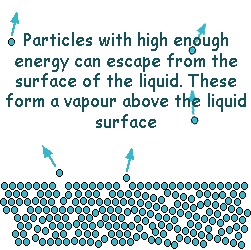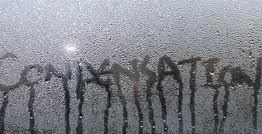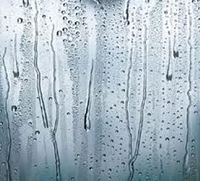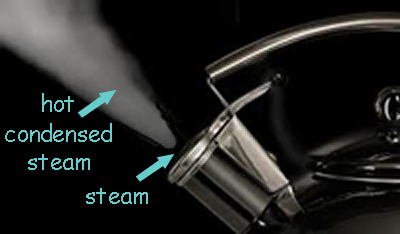Evaporation and Condensation Evaporation and condensation are changes of state.
Evaporation involves a liquid changing to a gas - varporisation.When that happens at a particular temperature called the boiling point, we call the process of vaporisation 'boiling' but when it happpens at a lower temperature we call it evaporation. The particles in a liquid at a given temperature have a range of energies. The temperature of a liquid is related to the average kinetic energy of the particles within the liquid. Therefore at any temperature some of the particles will have enough energy to escape from the liquid and become a gas. If these high energy particles are at the surface of the liquid they can escape, if they are deeper within the liquid they will interact with neighbouring particles and share out that excess energy. Once a high energy particle has escaped the remaining particles in the liquid will then have a lower average kinetic energy than before, so the temperature of the liquid will be lower than before - the liquid cools down as evaporation happens. The liquid will then be cooler than its surroundings and therefore will take in heat energy from the surroundings (heat energy always travels from hot to cold). This will raise the kinetic energy of the particles within the liquid and the whole process will start again.
If the clothing has fine threads there will be a bigger surface area for the water to escape from and it will dry more quickly that materials with dense threads. If the clothing is spread out to dry a bigger surface area is available from which the evaporation process can occur. If you overload your washing line and bunch all of the clothes together, they will not dry as efficiently as if you space them out. Condensation involves a gas changing to a liquid.
The air contains water vapour. Near to the window of a room the air gets very cold when the weather outside is cold. The particles in the air (including the water) give some of their energy to the window pane when they collide with it. Some of the water particles lose so much energy that they no longer have sufficient internal energy to remain in the vapour form. They give energy to the window pane as they change state and stick to the window and each other as liquid water. They form droplets of water rather than a fine film on the window pane because they are more attracted to each other than the glass. When the droplet is big enough, its weight causes it to dibble down the pane...
Steam is water that is above 100oC (the boiling point of water). It is the gaseous form of water and is a colourless gas. We cannot see steam. When we 'see' the 'steam' from a kettle, we are in fact seeing the water that has condensed from steam into droplets in the air. Look closely and you will see that there is a 'gap' where the steam leaves the kettle before it condenses... and it is invisible! In exams do not call water vapour 'steam'. The steam of hot condensed steam that you can see will also contain some pure steam that is invisible to you. If you put your hand into a stream of steam from a kettle it will scald your skin more severely than if you splash boiling water on it. Not only is the steam as hot as the boiling water, but energy due to its changing state is also released into your skin when the steam condenses. Factors affecting the rate of condensation and evaporationThe rate of condensation increases if the temperature of the gas is decreased or the pressure is increased. On the other hand, the rate of evaporation increases if the temperature of the liquid is increased or the pressure is decreased. It is also increased if the surface area of the liquid is increased or air is moving over the surface of the liquid. |
Follow me...
|












